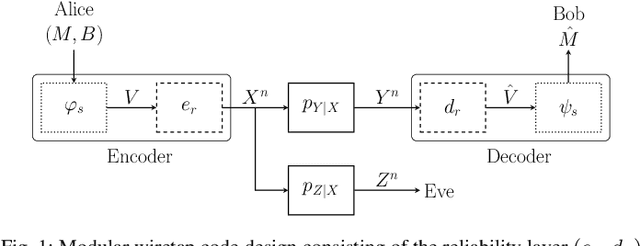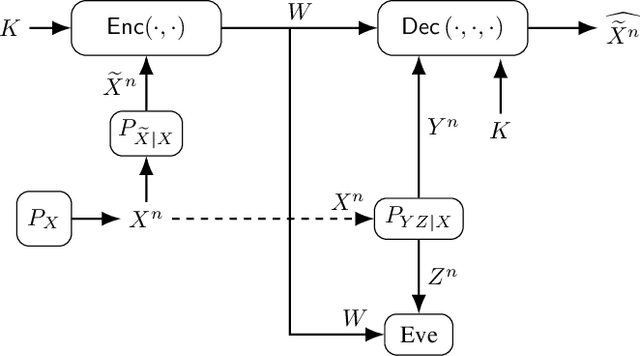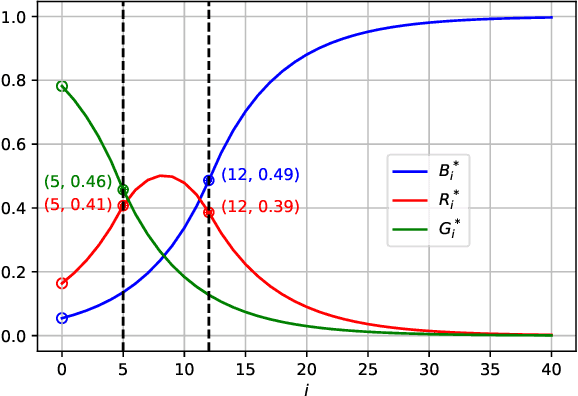Onur Günlü
Multi-hop Deep Joint Source-Channel Coding with Deep Hash Distillation for Semantically Aligned Image Retrieval
Oct 08, 2025Abstract:We consider image transmission via deep joint source-channel coding (DeepJSCC) over multi-hop additive white Gaussian noise (AWGN) channels by training a DeepJSCC encoder-decoder pair with a pre-trained deep hash distillation (DHD) module to semantically cluster images, facilitating security-oriented applications through enhanced semantic consistency and improving the perceptual reconstruction quality. We train the DeepJSCC module to both reduce mean square error (MSE) and minimize cosine distance between DHD hashes of source and reconstructed images. Significantly improved perceptual quality as a result of semantic alignment is illustrated for different multi-hop settings, for which classical DeepJSCC may suffer from noise accumulation, measured by the learned perceptual image patch similarity (LPIPS) metric.
The Role of ISAC in 6G Networks: Enabling Next-Generation Wireless Systems
Oct 06, 2025Abstract:The commencement of the sixth-generation (6G) wireless networks represents a fundamental shift in the integration of communication and sensing technologies to support next-generation applications. Integrated sensing and communication (ISAC) is a key concept in this evolution, enabling end-to-end support for both communication and sensing within a unified framework. It enhances spectrum efficiency, reduces latency, and supports diverse use cases, including smart cities, autonomous systems, and perceptive environments. This tutorial provides a comprehensive overview of ISAC's role in 6G networks, beginning with its evolution since 5G and the technical drivers behind its adoption. Core principles and system variations of ISAC are introduced, followed by an in-depth discussion of the enabling technologies that facilitate its practical deployment. The paper further analyzes current research directions to highlight key challenges, open issues, and emerging trends. Design insights and recommendations are also presented to support future development and implementation. This work ultimately try to address three central questions: Why is ISAC essential for 6G? What innovations does it bring? How will it shape the future of wireless communication?
Deep Learning-based Codes for Wiretap Fading Channels
Sep 13, 2024



Abstract:The wiretap channel is a well-studied problem in the physical layer security (PLS) literature. Although it is proven that the decoding error probability and information leakage can be made arbitrarily small in the asymptotic regime, further research on finite-blocklength codes is required on the path towards practical, secure communications systems. This work provides the first experimental characterization of a deep learning-based, finite-blocklength code construction for multi-tap fading wiretap channels without channel state information (CSI). In addition to the evaluation of the average probability of error and information leakage, we illustrate the influence of (i) the number of fading taps, (ii) differing variances of the fading coefficients and (iii) the seed selection for the hash function-based security layer.
Generalized Rainbow Differential Privacy
Sep 11, 2023Abstract:We study a new framework for designing differentially private (DP) mechanisms via randomized graph colorings, called rainbow differential privacy. In this framework, datasets are nodes in a graph, and two neighboring datasets are connected by an edge. Each dataset in the graph has a preferential ordering for the possible outputs of the mechanism, and these orderings are called rainbows. Different rainbows partition the graph of connected datasets into different regions. We show that if a DP mechanism at the boundary of such regions is fixed and it behaves identically for all same-rainbow boundary datasets, then a unique optimal $(\epsilon,\delta)$-DP mechanism exists (as long as the boundary condition is valid) and can be expressed in closed-form. Our proof technique is based on an interesting relationship between dominance ordering and DP, which applies to any finite number of colors and for $(\epsilon,\delta)$-DP, improving upon previous results that only apply to at most three colors and for $\epsilon$-DP. We justify the homogeneous boundary condition assumption by giving an example with non-homogeneous boundary condition, for which there exists no optimal DP mechanism.
Secure Integrated Sensing and Communication
Mar 20, 2023

Abstract:This work considers the problem of mitigating information leakage between communication and sensing in systems jointly performing both operations. Specifically, a discrete memoryless state-dependent broadcast channel model is studied in which (i) the presence of feedback enables a transmitter to convey information, while simultaneously performing channel state estimation; (ii) one of the receivers is treated as an eavesdropper whose state should be estimated but which should remain oblivious to part of the transmitted information. The model abstracts the challenges behind security for joint communication and sensing if one views the channel state as a key attribute, e.g., location. For independent and identically distributed states, perfect output feedback, and when part of the transmitted message should be kept secret, a partial characterization of the secrecy-distortion region is developed. The characterization is exact when the broadcast channel is either physically-degraded or reversely-physically-degraded. The partial characterization is also extended to the situation in which the entire transmitted message should be kept secret. The benefits of a joint approach compared to separation-based secure communication and state-sensing methods are illustrated with binary joint communication and sensing models.
Concatenated Classic and Neural (CCN) Codes: ConcatenatedAE
Sep 04, 2022



Abstract:Small neural networks (NNs) used for error correction were shown to improve on classic channel codes and to address channel model changes. We extend the code dimension of any such structure by using the same NN under one-hot encoding multiple times, which are serially-concatenated with an outer classic code. We design NNs with the same network parameters, where each Reed-Solomon codeword symbol is an input to a different NN. Significant improvements in block error probabilities for an additive Gaussian noise channel as compared to the small neural code are illustrated, as well as robustness to channel model changes.
Secure and Private Source Coding with Private Key and Decoder Side Information
May 10, 2022
Abstract:The problem of secure source coding with multiple terminals is extended by considering a remote source whose noisy measurements are the correlated random variables used for secure source reconstruction. The main additions to the problem include 1) all terminals noncausally observe a noisy measurement of the remote source; 2) a private key is available to all legitimate terminals; 3) the public communication link between the encoder and decoder is rate-limited; 4) the secrecy leakage to the eavesdropper is measured with respect to the encoder input, whereas the privacy leakage is measured with respect to the remote source. Exact rate regions are characterized for a lossy source coding problem with a private key, remote source, and decoder side information under security, privacy, communication, and distortion constraints. By replacing the distortion constraint with a reliability constraint, we obtain the exact rate region also for the lossless case. Furthermore, the lossy rate region for scalar discrete-time Gaussian sources and measurement channels is established.
Secure Joint Communication and Sensing
Feb 22, 2022
Abstract:This work considers mitigation of information leakage between communication and sensing operations in joint communication and sensing systems. Specifically, a discrete memoryless state-dependent broadcast channel model is studied in which (i) the presence of feedback enables a transmitter to simultaneously achieve reliable communication and channel state estimation; (ii) one of the receivers is treated as an eavesdropper whose state should be estimated but which should remain oblivious to a part of the transmitted information. The model abstracts the challenges behind security for joint communication and sensing if one views the channel state as a characteristic of the receiver, e.g., its location. For independent identically distributed (i.i.d.) states, perfect output feedback, and when part of the transmitted message should be kept secret, a partial characterization of the secrecy-distortion region is developed. The characterization is exact when the broadcast channel is either physically-degraded or reversely-physically-degraded. The characterization is also extended to the situation in which the entire transmitted message should be kept secret. The benefits of a joint approach compared to separation-based secure communication and state-sensing methods are illustrated with a binary joint communication and sensing model.
Rainbow Differential Privacy
Feb 08, 2022

Abstract:We extend a previous framework for designing differentially private (DP) mechanisms via randomized graph colorings that was restricted to binary functions, corresponding to colorings in a graph, to multi-valued functions. As before, datasets are nodes in the graph and any two neighboring datasets are connected by an edge. In our setting, we assume each dataset has a preferential ordering for the possible outputs of the mechanism, which we refer to as a rainbow. Different rainbows partition the graph of datasets into different regions. We show that when the DP mechanism is pre-specified at the boundary of such regions, at most one optimal mechanism can exist. Moreover, if the mechanism is to behave identically for all same-rainbow boundary datasets, the problem can be greatly simplified and solved by means of a morphism to a line graph. We then show closed form expressions for the line graph in the case of ternary functions. Treatment of ternary queries in this paper displays enough richness to be extended to higher-dimensional query spaces with preferential query ordering, but the optimality proof does not seem to follow directly from the ternary proof.
Function Computation Under Privacy, Secrecy, Distortion, and Communication Constraints
Jan 11, 2022
Abstract:The problem of reliable function computation is extended by imposing privacy, secrecy, and storage constraints on a remote source whose noisy measurements are observed by multiple parties. The main additions to the classic function computation problem include 1) privacy leakage to an eavesdropper is measured with respect to the remote source rather than the transmitting terminals' observed sequences; 2) the information leakage to a fusion center with respect to the remote source is considered as a new privacy leakage metric; 3) the function computed is allowed to be a distorted version of the target function, which allows to reduce the storage rate as compared to a reliable function computation scenario in addition to reducing secrecy and privacy leakages; 4) two transmitting node observations are used to compute a function. Inner and outer bounds on the rate regions are derived for lossless and lossy single-function computation with two transmitting nodes, which recover previous results in the literature. For special cases that include invertible and partially-invertible functions, and degraded measurement channels, exact lossless and lossy rate regions are characterized, and one exact region is evaluated for an example scenario.
 Add to Chrome
Add to Chrome Add to Firefox
Add to Firefox Add to Edge
Add to Edge